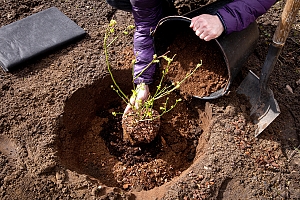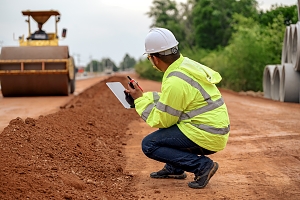Embarking on a landscaping, gardening, or construction project often involves moving earth—literally. Whether you’re leveling a backyard, creating a raised garden bed, or filling in a hole, determining how much dirt you need is a crucial step in the planning process. In this guide, we’ll delve into the factors that influence the quantity of fill dirt required for your project and provide you with the insights to ensure your earth-moving endeavors are a success.
Assessing Your Projects Fill Dirt Needs
 The first step in determining how much dirt you need is to clearly understand the scope of your project. Are you filling a small planter box, grading a lawn, or reshaping an entire landscape? Each scenario demands a different volume of soil. Measure the dimensions of the area you intend to fill or level, taking note of the length, width, and depth.
The first step in determining how much dirt you need is to clearly understand the scope of your project. Are you filling a small planter box, grading a lawn, or reshaping an entire landscape? Each scenario demands a different volume of soil. Measure the dimensions of the area you intend to fill or level, taking note of the length, width, and depth.
Calculating Volume
Once you have your measurements, you can calculate the volume of dirt needed. The formula for volume is straightforward: Length x Width x Depth. For example, if you’re filling a raised bed that measures 8 feet long, 4 feet wide, and you want 1 foot of soil, the calculation would be 8 x 4 x 1 = 32 cubic feet of dirt.
Understanding Cubic Yards
Most suppliers quote soil in cubic yards, so it’s important to convert your volume from cubic feet to cubic yards. Since there are 27 cubic feet in a cubic yard, you divide your cubic feet by 27. Using the previous example, 32 cubic feet would be approximately 1.19 cubic yards (32 ÷ 27 = 1.19).
Considering Compaction
Keep in mind that dirt can settle and compact over time. If your project involves filling a large hole or trench, you may need to account for compaction by ordering additional soil. Compaction rates can vary, but a general rule of thumb is to order about 10% more dirt than your initial calculation.
Choosing the Right Type of Soil
Choosing the right type of soil is a crucial step in ensuring the success of your project, whether it’s gardening, landscaping, or construction. Each type of soil serves a specific purpose, and understanding their characteristics is essential for optimal results.
- Topsoil: The uppermost layer of soil and is rich in organic matter. It’s ideal for planting and gardening because of its nutrient content.Use topsoil when creating new garden beds, flower beds, or when overseeding existing lawns. Its fertility supports healthy plant growth.
- Garden Soil: Pre-mixed blend of topsoil, compost, and other organic materials. It provides an enriched environment for plants to thrive. Suitable for raised beds, container gardening, and general planting. Garden soil improves water retention and nutrient availability.
- Fill Dirt: Primarily used to fill depressions or holes in the ground. It is often less fertile than topsoil and lacks the nutrients required for robust plant growth. Use fill dirt for leveling surfaces, filling low spots in the landscape, or creating a base for construction projects. It’s not suitable for planting due to its limited fertility.
Consulting with Professionals
If the calculations and considerations feel overwhelming, don’t hesitate to consult with landscaping or construction professionals. They can provide valuable insights based on their experience and help you refine your estimates.
Local Regulations and Environmental Considerations:
 Local regulations and environmental considerations play a crucial role in any project involving soil disposal, excavation, or modification. Before proceeding with your dirt order, it is imperative to thoroughly understand and comply with the guidelines set by local authorities.
Local regulations and environmental considerations play a crucial role in any project involving soil disposal, excavation, or modification. Before proceeding with your dirt order, it is imperative to thoroughly understand and comply with the guidelines set by local authorities.
Failure to adhere to these regulations may result in legal consequences and environmental damage. Here are key aspects to consider:
Local Regulations
Permits and Permissions: Check whether your project requires permits or permissions from local authorities. Excavation and soil disposal activities often necessitate official approvals. Ensure that you have obtained all the necessary paperwork to avoid legal complications.
Disposal Restrictions: Some regions have specific regulations regarding the disposal of soil, especially if it is contaminated or contains hazardous materials. Understand the disposal options available to you and follow the prescribed methods to protect both public health and the environment.
Excavation Depth Limits: Local regulations may dictate the permissible depth of excavation. Understanding these limits ensures compliance with safety standards and prevents potential structural issues in the surrounding area.
Environmental Impact Assessment
Soil Quality Assessment: If your project involves the removal of existing soil, assess its quality and potential impact on the environment. Contaminated soil can harm ecosystems and water sources, necessitating proper disposal or remediation.
Erosion Control Measures: Implement erosion control measures to prevent soil runoff into nearby water bodies. Sediment-laden runoff can degrade water quality and harm aquatic life. Strategies such as silt fences, erosion control blankets, or sediment basins can mitigate these risks.
Wildlife and Habitat Preservation: Consider the impact of your project on local wildlife and natural habitats. If your activities disturb sensitive ecosystems, take measures to minimize disruption and, if necessary, consult with environmental experts for guidance on preservation efforts.
Vegetation Protection: If existing vegetation is being removed, plan for its replacement or compensate for the loss. Planting native vegetation can aid in restoring the ecological balance and maintaining biodiversity.
Soil Reuse and Recycling
Reuse Opportunities: Explore options for reusing excavated soil on-site. When feasible, reusing soil reduces the need for disposal and minimizes environmental impact. This is particularly relevant for projects where the soil is uncontaminated and suitable for other purposes.
Recycling Initiatives: Investigate local soil recycling facilities that can process and treat excavated soil for reuse. Recycling soil aligns with sustainable practices, reducing the demand for new resources and minimizing the overall ecological footprint of your project.
By proactively addressing local regulations and considering environmental implications, you contribute to the responsible and sustainable execution of your project. Awareness of these factors not only ensures legal compliance but also fosters a commitment to environmental stewardship, promoting the long-term health of ecosystems and communities.
Reach Out to the Northern Virginia Fill Dirt Professionals
Determining how much dirt you need for your project involves careful planning and consideration of various factors. Remember, when in doubt, seek professional guidance to ensure your project’s success and create a solid foundation for your vision to flourish.
Ready to transform your project with top-notch fill dirt services? Get in touch with Dirt Connections, your trusted partner in Northern Virginia, is here to elevate your construction, landscaping, or excavation endeavors.








































